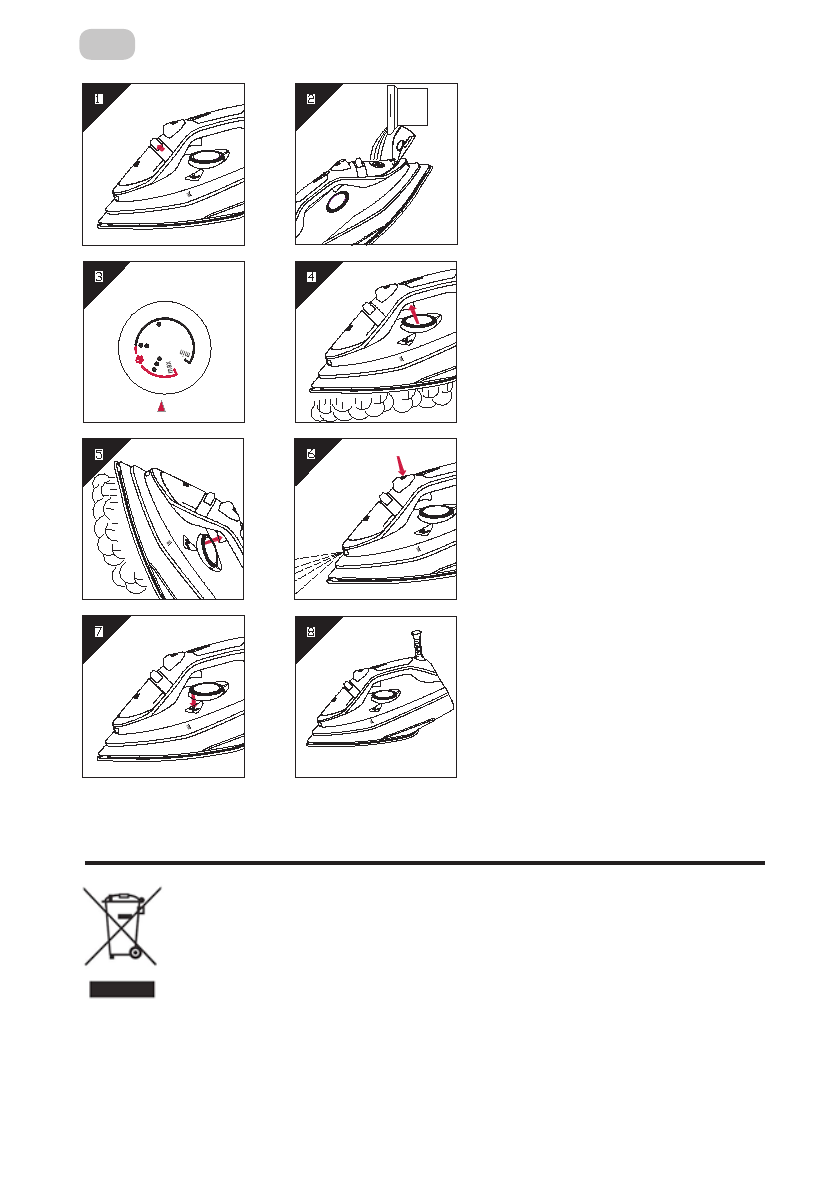Утюги Ardesto IR-C2232 - инструкция пользователя по применению, эксплуатации и установке на русском языке. Мы надеемся, она поможет вам решить возникшие у вас вопросы при эксплуатации техники.
Если остались вопросы, задайте их в комментариях после инструкции.
"Загружаем инструкцию", означает, что нужно подождать пока файл загрузится и можно будет его читать онлайн. Некоторые инструкции очень большие и время их появления зависит от вашей скорости интернета.

EN
20
5
- Disconnect the plug of the iron from the socket.
- Empty the reservoir by turning the iron upside down and gently shaking it.
- Leave the iron to cool down completely.
- Roll up the power cord with the rewinder
[Fig. 8]
.
- Always put the iron away in a vertical position.
ADVICE FOR GOOD IRONING
We recommend using the lowest temperatures with fabrics that have unusual finishes
(sequins, embroidery, flush, etc.).
If the fabric is mixed (e.g. 40% cotton 60% synthetics), set the thermostat to the
temperature of the fibre requiring the lower temperature.
If you don’t know the composition of the fabric, determine the suitable temperature
by testing on a hidden corner of the garment. Start with a low temperature and
increase it gradually until it reaches the ideal temperature.
Never iron areas with traces of perspiration or other marks: the heat of the plate fixes
the stains on the fabric, making them irremovable.
The size is more effective if you use a dry iron at a moderate temperature: excess
heat scorches it with the risk of forming a yellow mark.
To avoid marking silk, woolen or synthetic garments shiny, iron them inside out.
To avoid marking velvet garments shiny, iron in one direction (following the fibre)
and do not press down on the iron.
The heavier the washing machine is loaded, the more garments come out creased.
This also happens when the spin drying revolutions are very high.
Many fabrics are easier to iron if they are not completely dry.
For example, silk should always be ironed damp.
5
- Disconnect the plug of the iron from the socket.
- Empty the reservoir by turning the iron upside down and gently shaking it.
- Leave the iron to cool down completely.
- Roll up the power cord with the rewinder
[Fig. 8]
.
- Always put the iron away in a vertical position.
ADVICE FOR GOOD IRONING
We recommend using the lowest temperatures with fabrics that have unusual finishes
(sequins, embroidery, flush, etc.).
If the fabric is mixed (e.g. 40% cotton 60% synthetics), set the thermostat to the
temperature of the fibre requiring the lower temperature.
If you don’t know the composition of the fabric, determine the suitable temperature
by testing on a hidden corner of the garment. Start with a low temperature and
increase it gradually until it reaches the ideal temperature.
Never iron areas with traces of perspiration or other marks: the heat of the plate fixes
the stains on the fabric, making them irremovable.
The size is more effective if you use a dry iron at a moderate temperature: excess
heat scorches it with the risk of forming a yellow mark.
To avoid marking silk, woolen or synthetic garments shiny, iron them inside out.
To avoid marking velvet garments shiny, iron in one direction (following the fibre)
and do not press down on the iron.
The heavier the washing machine is loaded, the more garments come out creased.
This also happens when the spin drying revolutions are very high.
Many fabrics are easier to iron if they are not completely dry.
For example, silk should always be ironed damp.
CORRECT DISPOSAL OF THIS PRODUCT
This marking indicates that this product should not be disposed
with other household wastes. To prevent possible harm to
the environment or human health from uncontrolled waste
disposal, recycle it responsibly to promote the sustainable
reuse of material resources. To return your used device, please
use the return and collection systems or contact the retailer where the
product was purchased. They can take this product for environmental
safe recycling.
The heavier the washing
machine is loaded, the more
garments come out creased.
This also happens when the
spin drying revolutions are
very high.
Many fabrics are easier to iron
if they are not completely dry.
For example, silk should
always be ironed damp.
Характеристики
Остались вопросы?Не нашли свой ответ в руководстве или возникли другие проблемы? Задайте свой вопрос в форме ниже с подробным описанием вашей ситуации, чтобы другие люди и специалисты смогли дать на него ответ. Если вы знаете как решить проблему другого человека, пожалуйста, подскажите ему :)
























